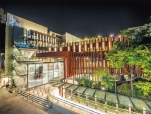Ko Shan Theatre New Wing: Theatre inside the Park

Ko Shan Road Park is a small park located in the To Kwa Wan district of Kowloon. Perched on a hill, the park is home to the Ko Shan Theatre. The Ko Shan Theatre was first opened in 1983 and designed as a 3,000-seat semi-open air theatre. Because of the semi-open design, the former venue suffered from inclement weather and noise problems. After an improvement project approved in 1994, the refurbished Ko Shan Theatre was re-opened in October 1996.
The former amphitheatre was demolished and rebuilt with an air-conditioned foyer block housing rehearsal facilities, committee room, exhibition facilities and URBTIX box office. The renovation aimed at providing better facilities for a wide range of public and private activities, which can intermix for the benefit of the community.Opened on 31 October 2014, the 5-storey Ko Shan Theatre New Wing comprises an 600-seat auditorium, an exhibition gallery, a function room, rehearsal rooms and singing practice rooms. It is also equipped with a green roof, a car park basement, a specialist store for Cantonese and Chinese opera products.
The New Wing together with the existing Ko Shan Theatre promotes and preserves cultural heritage of Cantonese Opera and beneficial to Hong Kong in taking the lead role in the development of this traditional art form in the Greater Pearl River Delta area.
At the beginning of this project, Ronald Lu & Partners (RLP) aims to create additional public facilities within an existing public park with minimum impact on its environment, while enhancing the theatre’s identity as Hong Kong’s hub for Cantonese opera. The project consists of a 600-seat auditorium, exhibition hall, rehearsal rooms, resource centre, restaurant and other ancillary facilities.
A-Theatre-Inside-A-Park
The New Wing negotiates harmoniously with the park’s existing topography, preserving the mature precious trees. External timberoutlook sun-shading fins dematerialize the building massing and blend subtly into the surrounding nature’s scale, textures and colours. A “Green Trail” extends vertically the at-grade park with the lavishly-landscaped terraces, a Tea-House, an Exhibition Gallery, a Cantonese-Opera Information Centre and a roof garden – “Moon Lawn”; injecting a fresh cultural and leisure experience to the community.
Full content of this issue you can read here
The full version of the article can be read in our printed issue, also you can subscribe to the web-version of the magazine
 Materials provided by Ronald Lu & Partners
Materials provided by Ronald Lu & Partners


